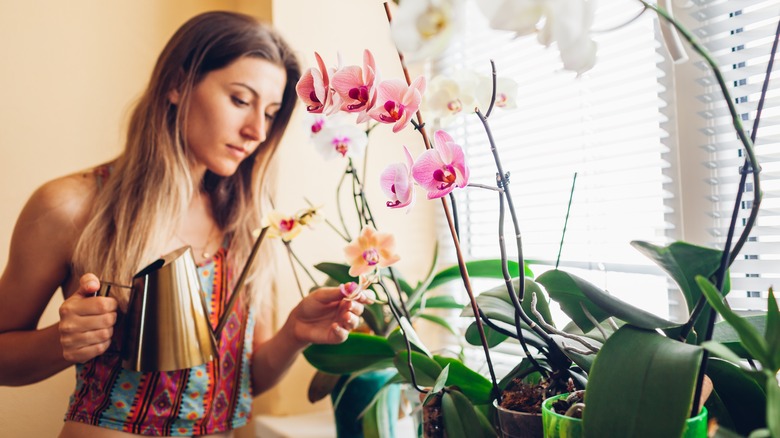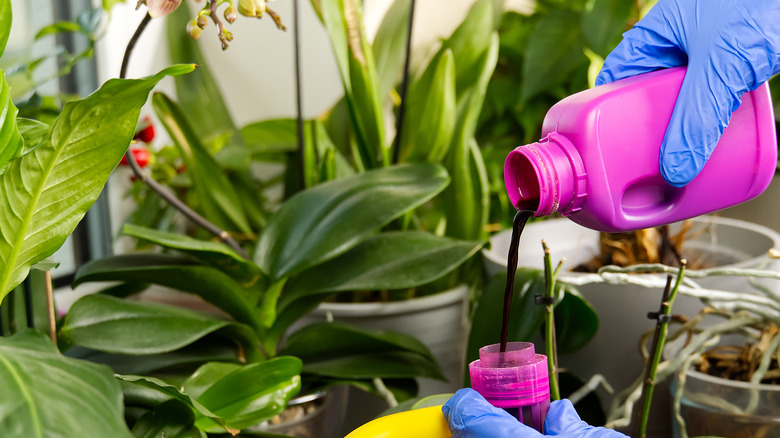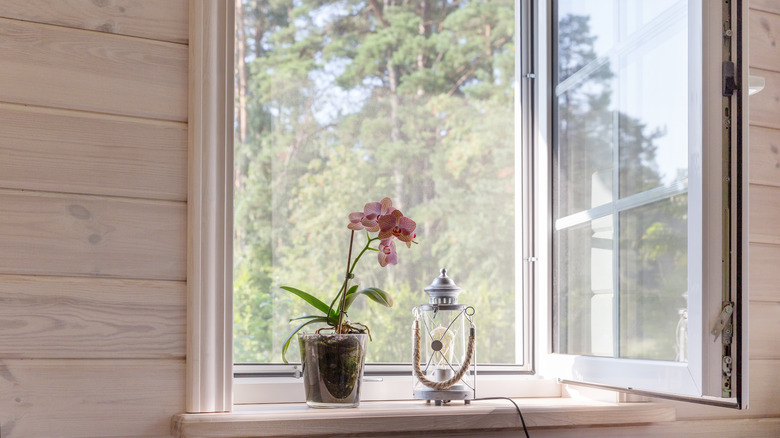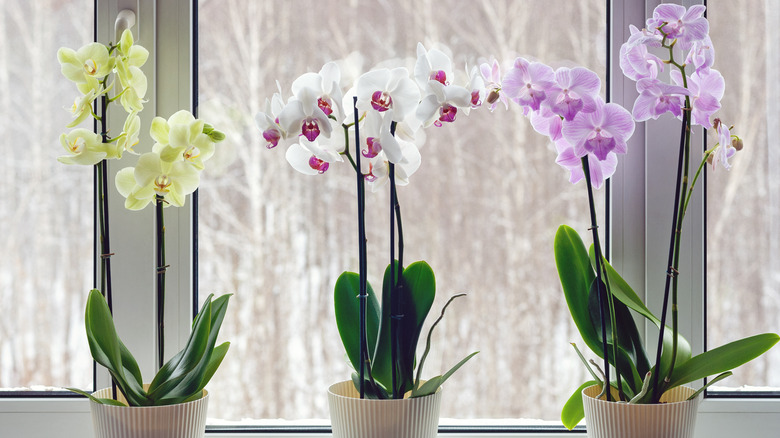How To Care For Orchids So They Rebloom Again, According To An Expert
There's no denying that orchids are absolutely gorgeous. However, if you don't have a particularly green thumb, there's a good chance you may have avoided this flower because of its reputation of being quite temperamental. However, as rePotme clarifies, you shouldn't be intimidated — while orchids do require different treatment than many other plants, you just need to learn how to care for them properly. And since they have the ability to rebloom, they could become a beautiful, fragrant addition to your space for years to come, making all your effort worth it.
In an exclusive interview with House Digest, Liz Will — a Master Gardener through Michigan State University Extension, certified garden coach, and garden consultant at Learn to Grow Gardens – gave us all the necessary information that will ensure your orchid thrives over and over again. "Orchids bloom once per year, on average, and then enter a period of dormancy in which they don't bloom," she explains. "Caring for your orchid properly during this time is essential to be sure that it blooms again."
Just as you need to do with outdoors trees and bushes, the first step is regularly trimming the plant. "Remove spent blooms to keep fresh ones blooming longer, and when your orchid is done blooming, trim the dying flower spike to no more than 3 inches in height," she recommends.
Read on to learn more of Will's tips for happy, healthy orchids, no matter which particular type of orchid you have.
Be patient
With any kind of plant, patience is often the name of the game. It can take weeks or, more commonly, months for those you're lovingly tending to actually grow and produce blossoms — and orchids are no different. In fact, they require a little more patience than other plants because of the uniquely annual pattern of their lifecycle. "Orchids enter a period of dormancy between blooms, which lasts six to nine months," Liz Will shares.
However, that period of dormancy isn't an excuse to toss your orchid on a shelf and forget about it until you think it's time for the flower to bloom again. "During this time, they still need to be properly cared for and fertilized," Will continues. "Good care during dormancy will ensure your orchid blooms again."
As Will's advice indicates, orchids aren't the type of plant that you tend to in one season and then ignore throughout the rest of the year. You'll want to make caring for your orchid a part of your constant routine if you want to be able to enjoy the beauty of the flower for a long time.
Water them properly
While you want to ensure your plant is receiving the moisture it needs to prevent dehydration, orchids have certain quirks that necessitate particular strategies for watering. They're not the type of plant that you can water whenever it comes to mind, trusting the soil will soak up any excess and keep the plant hydrated for days to come. "Orchids are a bit different than most houseplants in that they don't like moist soil, which can cause an orchid's roots to rot," Liz Will reveals. "To prevent this from happening, orchids need to be watered a little bit differently."
Will has two go-to strategies that she relies on. "One way is to soak your orchid in a bowl of water every week or two," she continues. "Alternatively, you can water orchids with the ice cube method. To do this, be sure the roots are covered with a layer of bark chips or moss. Once per week, place three ice cubes on top of the bark chips or moss, avoiding any plant roots."
In certain ways, orchids' particular needs in terms of watering actually makes them a little easier to deal with, as you don't need to water them every day. And, once you've mastered Will's go-to techniques to keep them properly hydrated, your orchid can focus on thriving rather than surviving. "Properly watering your orchid, even during dormancy, helps your orchid focus its energy on creating new blooms instead of recovering from improper watering," Will adds.
Fertilize two times per month
In addition to the right amount of water so that they don't become overly hydrated, another key component that many plants need is nutrients, which often come in the form of fertilizers. While you might think fertilizing is optional to get even more robust, healthy plants, it's actually a necessity, according to Liz Will. "Fertilizing orchids is important for the production of flowers, even during dormancy," she says. "Plants require nutrients for flower formation, and fertilizer helps provide these nutrients."
However, there are a few important considerations for when you're fertilizing orchids, and what exactly you're using to do so. "To fertilize orchids, use a 20-20-20 liquid fertilizer and use at ¼ strength, once every two weeks," advises Will. "You can also purchase fertilizers specifically for orchids, and follow the directions on the package." That's a surefire way to cultivate the conditions in which your orchid will thrive.
Provide proper lighting
Light is another critical factor for the growth of all plants. It's the reason that, if you're a plant lover with endless pots and specimens around your home, you've likely positioned them in strategic areas that receive the light that's best for them.
That's because it's not as simple as giving every plant the same amount of sunshine every day. Some plants do better in intense, direct sunlight, while others thrive in the shade. Orchids fall somewhere in the middle of the spectrum, as Liz Will outlines. "Orchids need bright indirect light, which means they need bright light, but not directly in the path of the sun's rays," she notes. In terms of where in your home you should place your orchid, she advises that "a location a few feet from an eastern or southern facing window is perfect."
And, there's even a handy way to check if you're doing a good job getting your orchid the light it needs. "If your orchid's leaves are bright green, it's a good indication it's receiving adequate light," adds Will.
Put them in a cooler spot at night
So you've figured out the spot in your home that has the ideal lighting for your orchid and you've confirmed those leaves are bright green and the plant appears to be thriving. You should probably leave your orchid in that exact spot year-round then, right? Well, not quite, according to Liz Will. "Temperature triggers blooming for a lot of orchids," she reveals. "There are different ranges in temperature that orchids prefer, depending on the type. Phalaenopsis is the most popular orchid, and easiest to rebloom. Phaelaenopsis need temperatures ranging from 55 to 65 degrees at night."
As you may well know, temperatures can often spike during the day and then drop at night, meaning that keeping your orchid in the same spot isn't always the best choice, even if it gets the best sunlight during the daytime. You want to be responsive to those changes in temperature that could potentially trigger your orchid. "This can be achieved by moving it closer to a window in the winter, or outside in the summer," Will continues. "Bring your orchid back into the warmth during the day, and place in indirect light. When a new flower spike appears, you can keep your orchid in its warm daytime spot."
If you have multiple orchids, it may require a little extra monitoring and shuffling of pots, but you'll be rewarded for your efforts by plants that happily bloom over and over again.





